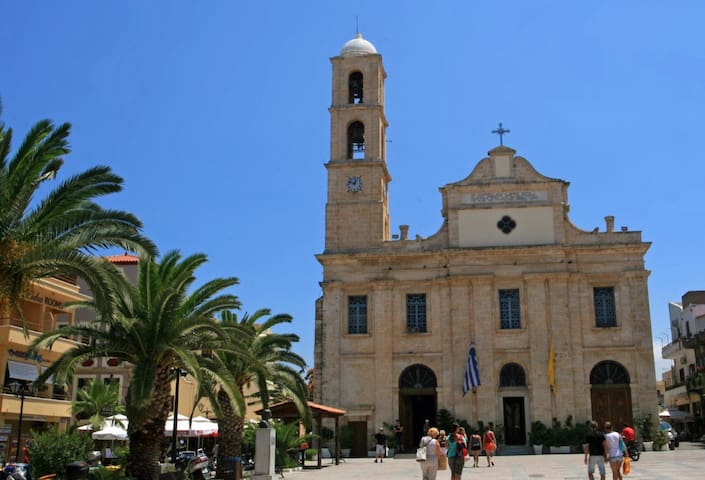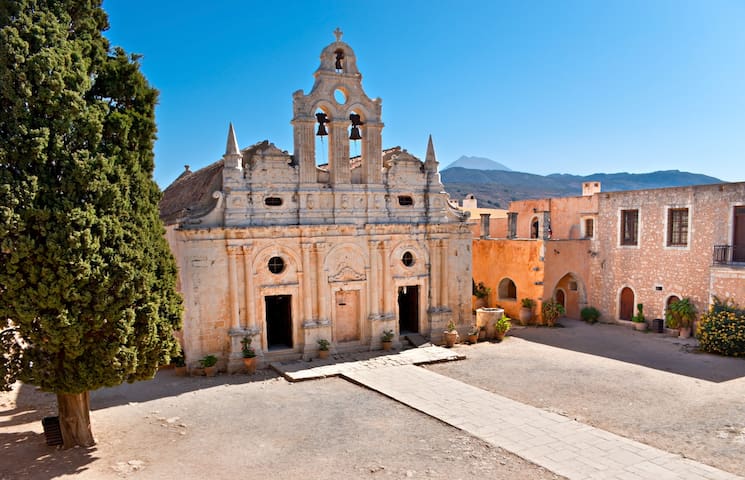Churches
In the center of the city of Chania, dominates the historic Trimartyri, the Holy Cathedral of Chania, the Church of the Assumption of the Virgin. The Holy Temple of the Entrances, as the Cathedral and Metropolitan and Patron Saint of the city, gathers all the religious, liturgical and in general worship interest of the pious people of Chania.
12 người dân địa phương đề xuất
Presentation of the Virgin Mary Holy Metropolitan Orthodox Church
18 MpetoloIn the center of the city of Chania, dominates the historic Trimartyri, the Holy Cathedral of Chania, the Church of the Assumption of the Virgin. The Holy Temple of the Entrances, as the Cathedral and Metropolitan and Patron Saint of the city, gathers all the religious, liturgical and in general worship interest of the pious people of Chania.
Gonia Monastery (or Panagia Odigitria) in Kolymbari, is the most known monastery in the northwest of Chania region. It is built just outside Kolymbari village, in a distance of less than a kilometer away, right after the village’s harbour.
The name Gonia Monastery means in Greek “Monastery of the Corner”, due to its excellent location.
Its other name, Monastery of Panagia Odigitria, means in Greek “Monastery of Mother Mary the Leader”. It has to do with the story about the first donor of the monastery, monk Vlassios from Cyprus, when he rebuilt it in the 17th century in its current location. According to tradition, he was led to the exact location by Mother Mary.
Gonia Monastery (Panagia Odigitria): A well-known monastery in Kolymbari, with great architecture and a fine ecclesiastical museum.
30 người dân địa phương đề xuất
Tu viện Gonia Odigitria
Gonia Monastery (or Panagia Odigitria) in Kolymbari, is the most known monastery in the northwest of Chania region. It is built just outside Kolymbari village, in a distance of less than a kilometer away, right after the village’s harbour.
The name Gonia Monastery means in Greek “Monastery of the Corner”, due to its excellent location.
Its other name, Monastery of Panagia Odigitria, means in Greek “Monastery of Mother Mary the Leader”. It has to do with the story about the first donor of the monastery, monk Vlassios from Cyprus, when he rebuilt it in the 17th century in its current location. According to tradition, he was led to the exact location by Mother Mary.
Gonia Monastery (Panagia Odigitria): A well-known monastery in Kolymbari, with great architecture and a fine ecclesiastical museum.
The Roman Catholic Church in Chania (1842) meets in the town centre at Halidon Street 46, the road that leads from 1866 Square down to the Venetian harbour. It is dedicated to the Virgin Mary and was inaugurated on April 25, 1879. It is in continuous operation until today and is the cathedral of the Catholic Diocese of Crete, which is also the parish church for the Catholic parish of Chania.
Πηγή: Catholic Church in Chania - Travel Guide for Island Crete, Greece cretanbeaches.com
https://www.cretanbeaches.com/en/cities-and-towns-in-crete/chania/religious-monuments-in-chania-city/catholic-church-in-chania
10 người dân địa phương đề xuất
Catholic Church
46 ChalidonThe Roman Catholic Church in Chania (1842) meets in the town centre at Halidon Street 46, the road that leads from 1866 Square down to the Venetian harbour. It is dedicated to the Virgin Mary and was inaugurated on April 25, 1879. It is in continuous operation until today and is the cathedral of the Catholic Diocese of Crete, which is also the parish church for the Catholic parish of Chania.
Πηγή: Catholic Church in Chania - Travel Guide for Island Crete, Greece cretanbeaches.com
https://www.cretanbeaches.com/en/cities-and-towns-in-crete/chania/religious-monuments-in-chania-city/catholic-church-in-chania
Until 1999 Etz Hayyim was a desecrated house of prayer that remained the sole Jewish monument on the Island of Crete after the destruction of our Jewish community in 1944. Essentially it stood as a monument to the success of the Nazis in obliterating 2,300 years of Jewish life on the island of Crete. From 1996 until the year of its re-dedication in 1999 the structure was painstakingly restored. The philosophy that directed this work is summed up in the Hebrew ‘Am Israel Hayy’ – ‘The people of Israel live’. In 1996, the Synagogue was mentioned on the World Monument Fund’s list of most endangered sites, but today it stands as a vibrant statement of Jewish life, vitality and values.
26 người dân địa phương đề xuất
Etz Hayyim Synagogue
Parodos KondilakiUntil 1999 Etz Hayyim was a desecrated house of prayer that remained the sole Jewish monument on the Island of Crete after the destruction of our Jewish community in 1944. Essentially it stood as a monument to the success of the Nazis in obliterating 2,300 years of Jewish life on the island of Crete. From 1996 until the year of its re-dedication in 1999 the structure was painstakingly restored. The philosophy that directed this work is summed up in the Hebrew ‘Am Israel Hayy’ – ‘The people of Israel live’. In 1996, the Synagogue was mentioned on the World Monument Fund’s list of most endangered sites, but today it stands as a vibrant statement of Jewish life, vitality and values.
Arkadi Monastery is located near the village Amnatos, 23km east of Rethymno. It is built at an altitude of 500m, on a fertile plateau with olive groves, vineyards, pine, cypress and oak trees. Around the monastery there are several picturesque chapels and from there starts the beautiful Arkadi gorge.
The exact date of the foundation of the monastery is not known, but it is believed that it was actually founded by Byzantine Emperor Arkadios in the 12th century. According to another version, the name is taken after a monk called Arkadios, who first founded the monastery. Moreover, the monastery was called Tsanli Manastir by the Turks (i.e. beneficiary bell), as the Arkadi monastery was the only Cretan monastery that had the right to ring its bells.
https://www.arkadimonastery.gr/home.html
262 người dân địa phương đề xuất
Arkadi
Arkadi Monastery is located near the village Amnatos, 23km east of Rethymno. It is built at an altitude of 500m, on a fertile plateau with olive groves, vineyards, pine, cypress and oak trees. Around the monastery there are several picturesque chapels and from there starts the beautiful Arkadi gorge.
The exact date of the foundation of the monastery is not known, but it is believed that it was actually founded by Byzantine Emperor Arkadios in the 12th century. According to another version, the name is taken after a monk called Arkadios, who first founded the monastery. Moreover, the monastery was called Tsanli Manastir by the Turks (i.e. beneficiary bell), as the Arkadi monastery was the only Cretan monastery that had the right to ring its bells.
https://www.arkadimonastery.gr/home.html
Gouverneto or Gderneto Monastery is located 19km east of Chania, on the north side of the Cape Akrotiri of Chania, near the monastery of Agia Triada Tzagarolon. It can be accessed through the Agia Triada, where there is a sign leading to the Gouverneto.
It is situated on a rocky site at an altitude of 260m, near the entrance of the gorge Avlaki and is built with fortress architecture and four towers with bastions protect its corners. The Gouverneto monastery was built before 1537, as proved by an inscription at the entrance of the fortress, being one of the oldest monasteries in Crete. It is believed that the monastery was founded by hermits and monks of the seaside Katholiko Monastery, who may built the new monastery over a pre-existing ancient temple so as to protect themselves from pirate raids.
The church of the monastery is dedicated to Virgin Mary, so it is also called Kyria ton Agelon (Lady of the Angels Monastery). It has a cruciform shape with a dome, while the entrance is decorated with relief representations of monsters. It was started being built during the Venetian Era, but the construction finished 2.5 centuries later, as the Turks invaded Crete and forbid building Christian temples.
Around the church of the monastery, which is located in the center of the courtyard, there are the other buildings of the complex. Among them are 50 monk cells in two floors, the dining room, a small museum, etc. Also, next to the church there are two chapels dedicated to Agii Deka (Saints Ten) and Saint John the Hermit.
St. John the Hermit lived in a cave in the gorge Avlaki, adjacent to the monastery, and is considered as the founder of the monastery. You can walk in Avlaki gorge by following the stone paved trail that descends to the sea. After 20 minutes of descent you will meet the Arkoudospilio Cave, and after a while the ruined monastery Katholiko and the cavernous church of St. John, where the hermit lived. After more 10 minutes, the gorge ends in a narrow rocky fjord with green waters.
The monastery is open on Monday, Tuesday, Thursday (9:00 to 12:00 and 17:00 to 19:00) and on weekends (9:00 to 11:00 and 17:00 to 20:00).
56 người dân địa phương đề xuất
Tu viện Gouverneto
Gouverneto or Gderneto Monastery is located 19km east of Chania, on the north side of the Cape Akrotiri of Chania, near the monastery of Agia Triada Tzagarolon. It can be accessed through the Agia Triada, where there is a sign leading to the Gouverneto.
It is situated on a rocky site at an altitude of 260m, near the entrance of the gorge Avlaki and is built with fortress architecture and four towers with bastions protect its corners. The Gouverneto monastery was built before 1537, as proved by an inscription at the entrance of the fortress, being one of the oldest monasteries in Crete. It is believed that the monastery was founded by hermits and monks of the seaside Katholiko Monastery, who may built the new monastery over a pre-existing ancient temple so as to protect themselves from pirate raids.
The church of the monastery is dedicated to Virgin Mary, so it is also called Kyria ton Agelon (Lady of the Angels Monastery). It has a cruciform shape with a dome, while the entrance is decorated with relief representations of monsters. It was started being built during the Venetian Era, but the construction finished 2.5 centuries later, as the Turks invaded Crete and forbid building Christian temples.
Around the church of the monastery, which is located in the center of the courtyard, there are the other buildings of the complex. Among them are 50 monk cells in two floors, the dining room, a small museum, etc. Also, next to the church there are two chapels dedicated to Agii Deka (Saints Ten) and Saint John the Hermit.
St. John the Hermit lived in a cave in the gorge Avlaki, adjacent to the monastery, and is considered as the founder of the monastery. You can walk in Avlaki gorge by following the stone paved trail that descends to the sea. After 20 minutes of descent you will meet the Arkoudospilio Cave, and after a while the ruined monastery Katholiko and the cavernous church of St. John, where the hermit lived. After more 10 minutes, the gorge ends in a narrow rocky fjord with green waters.
The monastery is open on Monday, Tuesday, Thursday (9:00 to 12:00 and 17:00 to 19:00) and on weekends (9:00 to 11:00 and 17:00 to 20:00).


